-
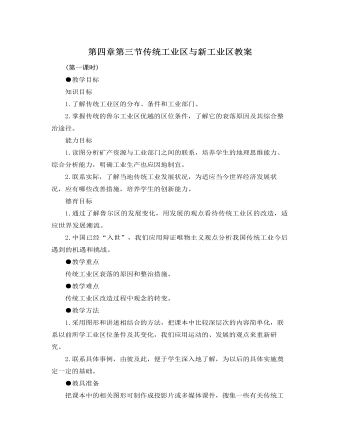
人教版新课标高中地理必修2第四章第三节传统工业区与新工业区教案
知识目标1.了解传统工业区的分布、条件和工业部门。2.掌握传统的鲁尔工业区优越的区位条件,了解它的衰落原因及其综合整治途径。能力目标1.读图分析矿产资源与工业部门之间的联系,培养学生的地理思维能力、综合分析能力,明确工业生产也应因地制宜。2.联系实际,了解当地传统工业发展状况,为适应当今世界经济发展状况,应有哪些改善措施,培养学生的创新能力。德育目标1.通过了解鲁尔区的发展变化,用发展的观点看待传统工业区的改造,适应世界发展潮流。2.中国已经“入世”,我们应用辩证唯物主义观点分析我国传统工业今后遇到的机遇和挑战。

人教版新课标高中地理必修2第二章第一节城市内部空间结构教案
为城市居民提供休养生息的场所,是城市最基本的功能区.城市中最为广泛的土地利用方式就是住宅用地.一般住宅区占据城市空间的40%—60%。(阅读图2.3)请同学讲解高级住宅区与低级住宅区的差别(学生答)(教师总结)(教师讲解)另外还有行政区、文化区等。而在中小城市,这些部门占地面积很小,或者布局分散,形成不了相应的功能 区。(教师提问)我们把城市功能区分了好几种,比如说住宅区,是不是土地都是被居住地占据呢?是不是就没有其他的功能了呢?(学生回答)不是(教师总结)不是的。我们说的住宅区只是在占地面积上,它是占绝大多数,但还是有土地是被其它功能占据的,比如说住宅区里的商店、绿化等也要占据一定的土地, 只是占的比例比较小而已。下面请看书上的活动题。
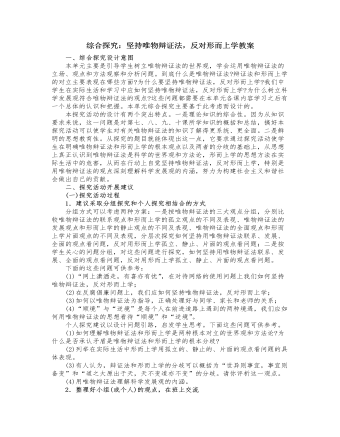
人教版高中政治必修4综合探究:坚持唯物辩证法,反对形而上学教案
5.循环经济当前,发展循环经济和知识经济已成为国际社会的两大趋势,有的发达国家甚至以立法的方式加以推进。循环经济本质上是一种生态经济,它要求运用生态学规律而不是机械的规律来指导人类社会的经济活动,减量化、再利用和资源化是其三大原则。传统经济是一种“资源——产品——污染排放”单向流动的线性经济,特征是高开采、低利用、高排放;与之不同,循环经济倡导的是一种与环境和谐的经济发展模式,它要求把经济活动组织成一个“资源——产品——再生资源”的反馈式流程,特征是低开采、高利用、低排放。目前,我国已经把发展循环经济作为编制“十一五”规划的重要指导原则。6.当心被优势“绊倒”有三个旅行者同时住进一家旅店,早上同时出门旅游。晚上归来时,拿伞的人淋得浑身是水,拿拐杖的人跌得满身是伤,而什么也没有带的人却安然无恙。
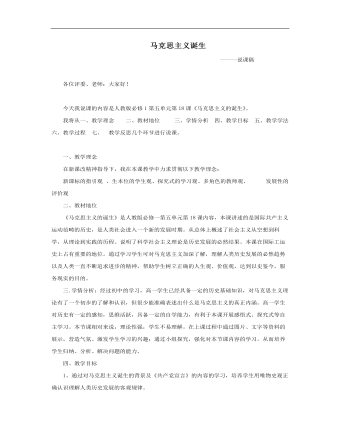
高中历史人教版必修一《马克思主义的诞生》说课稿
一、教学理念在新课改精神指导下,我在本课教学中力求贯彻以下教学理念:新课标的指引观 、生本位的学生观、探究式的学习观、多角色的教师观、 发展性的评价观二、教材地位《马克思主义的诞生》是人教版必修一第五单元第18课内容,本课讲述的是国际共产主义运动范畴的历史,是人类社会进入一个新的发展时期。从总体上概述了社会主义从空想到科学,从理论到实践的历程。说明了科学社会主义理论是历史发展的必然结果。本课在国际工运史上占有重要的地位。通过学习学生可对马克思主义加深了解,理解人类历史发展的必然趋势以及人类一直不断追求进步的精神,帮助学生树立正确的人生观、价值观,达到以史鉴今,服务现实的目的。
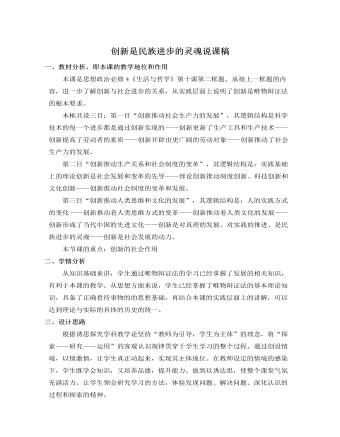
人教版高中政治必修4创新是民族进步的灵魂说课稿(二)
“蛟龙号”深潜器的总设计师——中船重工第七〇二研究所的徐芑南,他先后三次被评为江苏省和无锡市劳模,曾被评为上海市科技功臣,有十几个国家、部、省、市级科技进步奖项与他的名字相联。在徐芑南眼中,这些都只是“副产品”,为国家设计出最需要的潜水器,让中国具备从“浅蓝”走向“深蓝”的能力,这才是他最大的愿望。每当说到大洋的海底世界,徐芑南的语速快了起来:“海底有好多资源,等着我们去发现、去利用,我们不能落在别人的后面!”海底有石油,海底有许多未知的生物,还有锰结核、钴结壳、热液硫化物……“蛟龙号”的立项目的就是为了探明神秘的深海世界,造福人类。探究活动二:结合材料和教材,阐述创新与人类思维方式变革的关系。(设计意图)通过学生们感兴趣的材料,对本课的教学难点加以突破。

人教版高中历史必修3现代中国教育的发展说课稿
一、教材分析下面我来谈一谈对教材的认识:主要从教材的地位和作用、以及在此基础上确立的教学目标、教学重难点这三个方面来谈。首先,来谈教材的地位和作用:本课教材内容主要从三个方面向学生介绍了现代中国教育的发展状况和趋势:人民教育的奠基、动乱中的教育和教育的复兴,全面讲述了新中国教育的三个阶段。本课是文化史中中国史部分的最后一课, 也是必修三册书中唯一涉及教育的一课。而教育是思想文化史中的重要组成部分,江泽民同志在谈到教育的时候曾经说过,“百年大计,教育为本。教育为本,在于育人”。教育是关系国计民生的大事。学生通过学习新中国教育发展的史实,理解“科教兴国”、“国运兴衰,系于教育”的深刻含义。最终由此激发学生树立“知识改变命运、读书成就人生”的信念,树立勤奋学习、成人成才、报效祖国、服务社会的崇高理想。故本课的教学有极大的现实意义。谈完了教材的地位和作用,我再分析一下教学目标:

人教版高中数学选择性必修二等比数列的前n项和公式 (2) 教学设计
二、典例解析例10. 如图,正方形ABCD 的边长为5cm ,取正方形ABCD 各边的中点E,F,G,H, 作第2个正方形 EFGH,然后再取正方形EFGH各边的中点I,J,K,L,作第3个正方形IJKL ,依此方法一直继续下去. (1) 求从正方形ABCD 开始,连续10个正方形的面积之和;(2) 如果这个作图过程可以一直继续下去,那么所有这些正方形的面积之和将趋近于多少?分析:可以利用数列表示各正方形的面积,根据条件可知,这是一个等比数列。解:设正方形的面积为a_1,后续各正方形的面积依次为a_2, a_(3, ) 〖…,a〗_n,…,则a_1=25,由于第k+1个正方形的顶点分别是第k个正方形各边的中点,所以a_(k+1)=〖1/2 a〗_k,因此{a_n},是以25为首项,1/2为公比的等比数列.设{a_n}的前项和为S_n(1)S_10=(25×[1-(1/2)^10 ] )/("1 " -1/2)=50×[1-(1/2)^10 ]=25575/512所以,前10个正方形的面积之和为25575/512cm^2.(2)当无限增大时,无限趋近于所有正方形的面积和

人教版高中数学选择性必修二等差数列的前n项和公式(2)教学设计
课前小测1.思考辨析(1)若Sn为等差数列{an}的前n项和,则数列Snn也是等差数列.( )(2)若a1>0,d<0,则等差数列中所有正项之和最大.( )(3)在等差数列中,Sn是其前n项和,则有S2n-1=(2n-1)an.( )[答案] (1)√ (2)√ (3)√2.在项数为2n+1的等差数列中,所有奇数项的和为165,所有偶数项的和为150,则n等于( )A.9 B.10 C.11 D.12B [∵S奇S偶=n+1n,∴165150=n+1n.∴n=10.故选B项.]3.等差数列{an}中,S2=4,S4=9,则S6=________.15 [由S2,S4-S2,S6-S4成等差数列得2(S4-S2)=S2+(S6-S4)解得S6=15.]4.已知数列{an}的通项公式是an=2n-48,则Sn取得最小值时,n为________.23或24 [由an≤0即2n-48≤0得n≤24.∴所有负项的和最小,即n=23或24.]二、典例解析例8.某校新建一个报告厅,要求容纳800个座位,报告厅共有20排座位,从第2排起后一排都比前一排多两个座位. 问第1排应安排多少个座位?分析:将第1排到第20排的座位数依次排成一列,构成数列{an} ,设数列{an} 的前n项和为S_n。
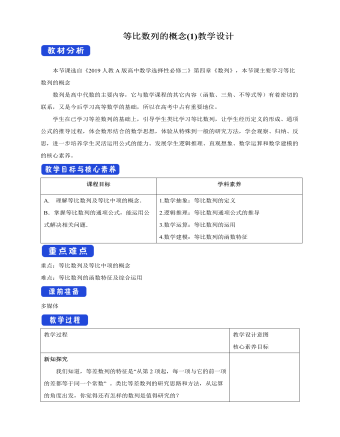
人教版高中数学选择性必修二等比数列的概念 (1) 教学设计
新知探究我们知道,等差数列的特征是“从第2项起,每一项与它的前一项的差都等于同一个常数” 。类比等差数列的研究思路和方法,从运算的角度出发,你觉得还有怎样的数列是值得研究的?1.两河流域发掘的古巴比伦时期的泥版上记录了下面的数列:9,9^2,9^3,…,9^10; ①100,100^2,100^3,…,100^10; ②5,5^2,5^3,…,5^10. ③2.《庄子·天下》中提到:“一尺之锤,日取其半,万世不竭.”如果把“一尺之锤”的长度看成单位“1”,那么从第1天开始,每天得到的“锤”的长度依次是1/2,1/4,1/8,1/16,1/32,… ④3.在营养和生存空间没有限制的情况下,某种细菌每20 min 就通过分裂繁殖一代,那么一个这种细菌从第1次分裂开始,各次分裂产生的后代个数依次是2,4,8,16,32,64,… ⑤4.某人存入银行a元,存期为5年,年利率为 r ,那么按照复利,他5年内每年末得到的本利和分别是a(1+r),a〖(1+r)〗^2,a〖(1+r)〗^3,a〖(1+r)〗^4,a〖(1+r)〗^5 ⑥
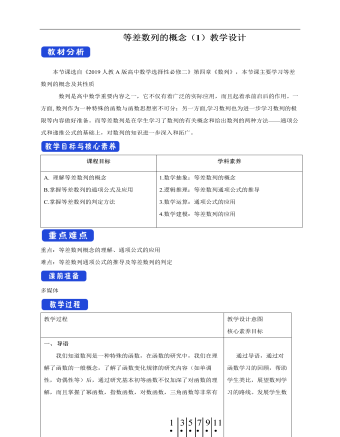
人教版高中数学选择性必修二等差数列的概念(1)教学设计
我们知道数列是一种特殊的函数,在函数的研究中,我们在理解了函数的一般概念,了解了函数变化规律的研究内容(如单调性,奇偶性等)后,通过研究基本初等函数不仅加深了对函数的理解,而且掌握了幂函数,指数函数,对数函数,三角函数等非常有用的函数模型。类似地,在了解了数列的一般概念后,我们要研究一些具有特殊变化规律的数列,建立它们的通项公式和前n项和公式,并应用它们解决实际问题和数学问题,从中感受数学模型的现实意义与应用,下面,我们从一类取值规律比较简单的数列入手。新知探究1.北京天坛圜丘坛,的地面有十板布置,最中间是圆形的天心石,围绕天心石的是9圈扇环形的石板,从内到外各圈的示板数依次为9,18,27,36,45,54,63,72,81 ①2.S,M,L,XL,XXL,XXXL型号的女装上对应的尺码分别是38,40,42,44,46,48 ②3.测量某地垂直地面方向上海拔500米以下的大气温度,得到从距离地面20米起每升高100米处的大气温度(单位℃)依次为25,24,23,22,21 ③
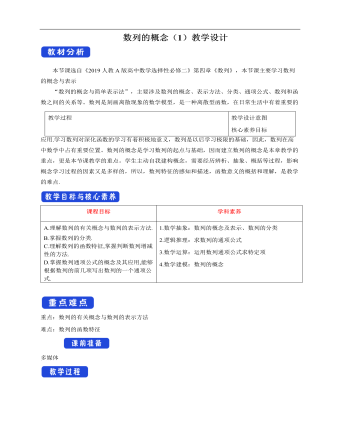
人教版高中数学选择性必修二数列的概念(1)教学设计
情景导学古语云:“勤学如春起之苗,不见其增,日有所长”如果对“春起之苗”每日用精密仪器度量,则每日的高度值按日期排在一起,可组成一个数列. 那么什么叫数列呢?二、问题探究1. 王芳从一岁到17岁,每年生日那天测量身高,将这些身高数据(单位:厘米)依次排成一列数:75,87,96,103,110,116,120,128,138,145,153,158,160,162,163,165,168 ①记王芳第i岁的身高为 h_i ,那么h_1=75 , h_2=87, 〖"…" ,h〗_17=168.我们发现h_i中的i反映了身高按岁数从1到17的顺序排列时的确定位置,即h_1=75 是排在第1位的数,h_2=87是排在第2位的数〖"…" ,h〗_17 =168是排在第17位的数,它们之间不能交换位置,所以①具有确定顺序的一列数。2. 在两河流域发掘的一块泥板(编号K90,约生产于公元前7世纪)上,有一列依次表示一个月中从第1天到第15天,每天月亮可见部分的数:5,10,20,40,80,96,112,128,144,160,176,192,208,224,240. ②
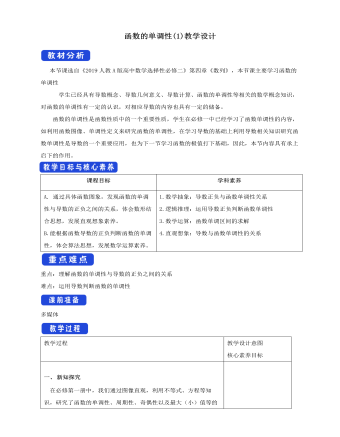
人教版高中数学选择性必修二函数的单调性(1) 教学设计
1.判断正误(正确的打“√”,错误的打“×”)(1)函数f (x)在区间(a,b)上都有f ′(x)<0,则函数f (x)在这个区间上单调递减. ( )(2)函数在某一点的导数越大,函数在该点处的切线越“陡峭”. ( )(3)函数在某个区间上变化越快,函数在这个区间上导数的绝对值越大.( )(4)判断函数单调性时,在区间内的个别点f ′(x)=0,不影响函数在此区间的单调性.( )[解析] (1)√ 函数f (x)在区间(a,b)上都有f ′(x)<0,所以函数f (x)在这个区间上单调递减,故正确.(2)× 切线的“陡峭”程度与|f ′(x)|的大小有关,故错误.(3)√ 函数在某个区间上变化的快慢,和函数导数的绝对值大小一致.(4)√ 若f ′(x)≥0(≤0),则函数f (x)在区间内单调递增(减),故f ′(x)=0不影响函数单调性.[答案] (1)√ (2)× (3)√ (4)√例1. 利用导数判断下列函数的单调性:(1)f(x)=x^3+3x; (2) f(x)=sinx-x,x∈(0,π); (3)f(x)=(x-1)/x解: (1) 因为f(x)=x^3+3x, 所以f^' (x)=〖3x〗^2+3=3(x^2+1)>0所以f(x)=x^3+3x ,函数在R上单调递增,如图(1)所示
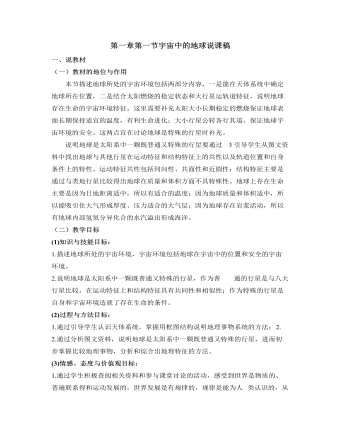
人教版高中地理必修1第一章第一节宇宙中的地球说课稿
(一)教材的地位与作用本节描述地球所处的宇宙环境包括两部分内容,一是能在天体系统中确定地球所在位置,二是结合太阳燃烧的稳定状态和大行星运轨道特征,说明地球存在生命的宇宙环境特征。这里需要补充太阳大小长期稳定的燃烧保证地球表面长期保持适宜的温度,有利生命进化;大小行星公转各行其道,保证地球宇宙环境的安全。这两点宜在讨论地球是特殊的行星时补充。说明地球是太阳系中一颗既普通又特殊的行星要通过 3引导学生从图文资料中找出地球与其他行星在运动特征和结构特征上的共性以及轨道位置和自身条件上的特性。运动特征共性包括同向性、共面性和近圆性;结构特征主要是通过与类地行星比较得出地球在质量和体积方面不具特殊性。地球上存在生命主要是因为日地距离适中,所以有适合的温度;因为地球质量和体积适中,所以能吸引住大气形成厚度、压力适合的大气层;因为地球存在岩浆活动,所以有地球内部氢氧分异化合的水汽溢出形成海洋。
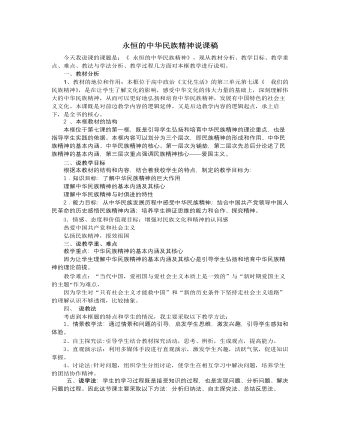
人教版高中政治必修3永恒的中华民族精神说课稿
(4)自强不息 (引导学生简要了解介绍 “大禹治水”“ 愚公移山”“ 夸父追日”“ 富贵不能淫”等典故名言,注重从优秀传统文化和中华民族精神之间的关系角度总结。)三、永远高扬的爱国主义旗帜这一目讲述中华民族精神的核心,新时期爱国主义的主题。【探究三】:1、团结统一、爱好和平、勤劳勇敢、自强不息共同体现着一个什么主题?2、你知道哪些我国抒发爱国情怀的诗词格言警句?哪些历史故事或者你身边的事例体现出了爱国主义的精神追求?你认为新时期我国爱国主义主要体现在哪些方面?学生四人一个小组讨论,选派代表发言【师生总结】:1、爱国主义是中华民族精神的核心,是中华民族的精神支柱。2、新时期爱国主义的主题:爱国主义是具体的,不同时期有不同的内涵,新时期爱国与爱社会主义本质上是一致的,发展中国特色社会主义,拥护祖国统一是新时期爱国主义的主题。
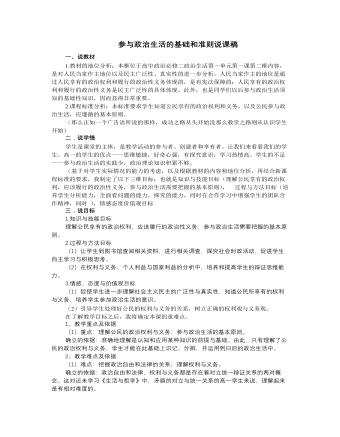
人教版高中政治必修2参与政治生活的基础和准则说课稿
观点一:没有无义务的权利,也没有无权利的义务;观点二权利与义务是完全对等的。根据学生的回答,教师点拨归纳,一般来说,权利与义务是对等的,因为没有义务的权利只能是特权,而没有权利的义务只能是奴役,只有将权利与义务有机结合起来,才能构成一个符合社会发展要求的公民社会,在讨论和思考中,使学生树立正确的观点,引导学生多方面、多角度地辩证认识权利与义务的关系。(3)个人利益和国家利益相结合的原则。引出汶川大地震中一些先进人物事迹,但另外也有一些人发国难财的人,如黑心棉事件等,针对上述材料,请同学们谈谈自己的看法。引导学生理解国家和公民个人利益在根本上是一致的,当个人利益与国家利益发生矛盾时,个人利益要服从国家利益。通过案例分析,培养学生获取信息的能力,自主学习的能力以及全面看问题的能力,再结合教师的讲授,给学生一种茅塞顿开的感觉。
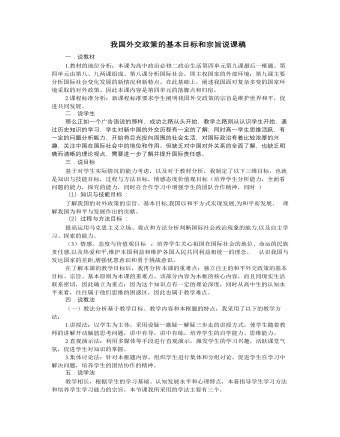
人教版高中政治必修2我国外交政策的基本目标和宗旨说课稿
环节四 课堂小结 巩固知识本节课我采用线索性的板书,整个知识结构一目了然,为了充分发挥学生在课堂的主体地位,我将课堂小结交由学生完成,请学生根据课堂学习的内容,结合我的板书设计来进行小结,以此来帮助教师在第一时间掌握学生学习信息的反馈,同时培养学生归纳分析能力、概括能力。环节五 情景回归,情感升华我的实习指导老师告诉过我们,政治这一门学科要从生活中来到生活去,所以在课堂的最后布置课外作业,以此培养学生对理论的实际运用能力,同时检验他们对知识的真正掌握情况,以此达到情感的升华,本节课,我根据建构主义理论,强调学生是学习的中心,学生是知识意义的主动建构者,是信息加工的主体,要强调学生在课堂中的参与性、以及探究性,不仅让他们懂得知识,更让他们相信知识,并且将知识融入到实践当中去,最终达到知、情、意、行的统一。

人教版高中生物必修1细胞器—系统内的分工合作说课稿
②与学牛的牛活经验相关,有利激发学列的兴趣。⑧利用多媒体让学牛通过观看、比较、讨论,加深理解f-J利掌握细胞内的牛要细胞器的结构及其功能。④学牛白丰学习,丰动建构新知识。⑤为完成后面的达标图表做充分的准备。4、概括反馈:①设讣达标表格,引导学牛完成。②应用该表格进行小结。③推荐相关网站,以解决课后遇到的附加题。这样设置的理由是①通过完成表格,归纳各种细胞器的结构和功能,使学牛更好的掌握本节课的内容。②培养学牛的分析问题和归纳总结的能力③培养学牛的竞争意识和团队合作精神。④拓展了教育资源,为学牛提供了一个白丰学习的空间。[课堂小结]请4-5位学牛来总结本节课的学刊内容和白己掌握的情况。请教师重新出示“八种细胞器的比较表”和“植物细胞和动物细胞的比较表”对本节内容的知识点、重点、难点进行总结。
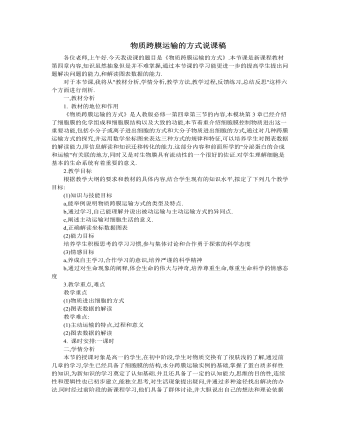
人教版高中生物必修1物质跨膜运输的方式说课稿
(4)提出问题:三种运输方式有哪些异同 组织学生分析填表,反馈和纠正.提出问题:影响自由扩散,协助扩散和主动运输速度的主要因素各是什么 画出细胞对某物的自由扩散,协助扩散和主动运输速度随细胞外浓度的改变而变化的曲线图组织学生分组讨论,并作图,展示各组的成果.教学说明:本环节巩固理论知识是对课本知识扩展和对重点,难点内容的深入理解和总结,只有理解了三种运输方式的异同,才能完成本环节教学任务,既突显书本知识,又培养学生的团结协作的精神,提高学生制做图表的能力和抽象化思维能力的形成.2.大分子的运输引导学生回忆分泌蛋白的分泌过程,得出胞吐现象,提出问题:那大家知道白细胞是如何吃掉病菌的吗 显示有关图片.强调:胞吞和胞吐作用都需要能量提出问题:胞吞和胞吐体现了细胞膜结构的特点是什么 与书本前面知识相联系.(四)技能训练指导学生就《技能训练》部分进行讨论五,反馈练习1.教师小结几种运输方式,特别是自由扩散,协助扩散和主动运输的特点
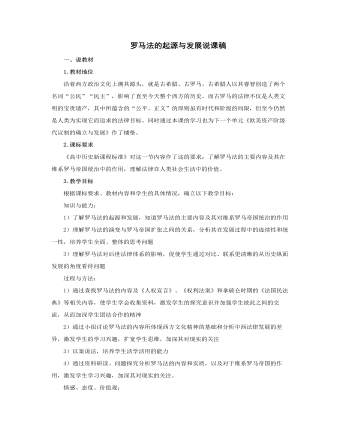
人教版高中历史必修1罗马法的起源与发展说课稿
学生思考回答后归纳:随着征服地区的扩大,出现了许多新问题,新矛盾,原有的公民法已经无法适应这些新变化(质疑)。公民法适用范围限于罗马公民,用来调整他们之间的关系,罗马公民受到法律保护,并享受法律赋予的权利。在扩张中纳入到疆域中的许多外邦人不能受到法律的保护,在这种背景下,公民法发展成万民法。万民法的出现,一方面由于公民法的狭隘性,另一方面伴随对外战争的胜利,奴隶制在罗马得到快速发展。为了更加有效地保护奴隶主的私人利益,迫切需要建立和完善法律制度来维护统治阶级的利益不受侵犯。问题探究:万民法的制定产生哪些作用?学生思考回答后总结:万民法取代公民法,协调了罗马人和外邦人之间的关系及外邦人相互之间的关系,对于在庞大帝国内微细,协调各地区的民族关系、社会矛盾也祈祷重要作用。万民法使法律具有了更大的适用范围,也成为巩固罗马统治的重要工具。

人教版高中生物必修1物质跨膜运输的实例说课稿
(四)、成果交流教师出示成熟植物细胞图,提出原生质层的概念,小组交流,教师点拨,得出结论:1、原生质层相当于半透膜2、外界溶液浓度大于细胞液浓度---细胞失水(质壁分离)3、外界溶液浓度小于细胞液浓度---细胞失水(质壁分离复原)教师出示有关细胞选择性吸收离子的数据资料。引导学生发现并探究出不同植物对同一离子吸收量不同,同一植物对不同离子吸收量也不同,得出结论:4、细胞膜具有选择透过性(五)拓展延伸如何用已有知识和技能鉴别两种蔗糖溶液浓度的大小?用0.1g/mg 0.8g/mg的蔗糖溶液分别做前面的探究实验会有什么不同的结果?你得出的结论是什么?引导学生总结出发生质壁分离和质壁分离复原的条件。五、板书设计好的板书就像一份微型教案,此板书力图全面而简明的将授课内容传递给学生,清晰直观,便于学生理解和记忆,理清文章脉络。

